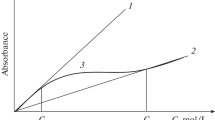Abstract
The pH value of buffer solutions is crucially dependent on the relative concentrations of all species in solution. The addition of water or neutral salt can have a significant effect on the pH of a buffer solution. This study examines the magnitude of the "dilution effect" and the "salt effect" for several commonly used inorganic and biological buffers. Novel data are obtained for the change in pH observed upon dilution or addition of neutral salt to these buffers which add to, complement and extend existing literature values. The validity of considering the dilution and salt effects as a combined ionic strength effect is also considered as well as the ability of the pH measuring device to perform valid measurements in these extreme conditions.





Similar content being viewed by others
References
Buck RP, Rondinini S, Covington AK, Baucke FG, Brett CM, Camões MF, Milton MJT, Mussini T, Naumann R, Pratt KW, Spitzer P, Wilson GS (2002), Pure Appl Chem 74:2105
Bates RG (1973) Determination of pH: theory and practice. Wiley, New York
Galster H (1991) pH measurement. VCH, New York.
Pfannenstiel E (2002) Intech 49:48
Comer JEA, Hibbert C (1997) J Autom Chem 19:213
Spitzer P (2001), Accred Qual Assur 6:55
Van Slyke DD (1922) J Biol Chem 52:525
deLevie R (1999) Aqueous acid-base equilibria and titrations. Oxford University Press, Oxford
Bates RG (1954) Anal Chem 26:871
Kortium G (1942) Z Elekrochem 48:145
Tishchenko PY, Wong CS, Pavlova GY, Johnson WK, Kang DJ, Kim KR (2001) Oceanology 41:813
Covington AK, Whitfield M (1988) Pure Appl Chem 60:865
Ekeltchik I, Kardash-Strochkova E, Dreazen O, Kuselman I (2002) Accred Qual Assur 7:412
Metcalf RC (1987) Analyst 112:1573
Naumann R, Weber A, Eberhardt R, Giera J, Spitzer P (2002) Anal Bioanal Chem 374:778
Degner R (2002) Anal Bioanal Chem 374:831
Leito I, Strauss L, Koort E, Pihl V (2002) Accred Qual Assur 7:242
Waite ER, March JB (2001) Fems Microbiol Lett 201:291
Wu YC, Feng D, Koch WF (1991) J Res Natl Inst Stand Technol 96:757
Schwabe K (1964) Z Phys Chem 41:368
Bates RG, Acree SF (1945) J Res Natl Bur Stand 34:373
Robinson RA, Stokes RH (1970) Electrolyte solutions. Butterworths, London
Bates RG, Diamond PT, Eden M, Acree SF (1946) J Res Natl Bur Stand 37:251
Acknowledgements
The authors are indebted to Professor A.K. Covington for useful discussion during the preparation and review of this manuscript.
Author information
Authors and Affiliations
Corresponding author
Rights and permissions
About this article
Cite this article
Brown, R.J.C., Milton, M.J.T. Observation of a combined dilution and salting effect in buffers under conditions of high dilution and high ionic strength. Accred Qual Assur 8, 505–510 (2003). https://doi.org/10.1007/s00769-003-0689-6
Received:
Accepted:
Published:
Issue Date:
DOI: https://doi.org/10.1007/s00769-003-0689-6




